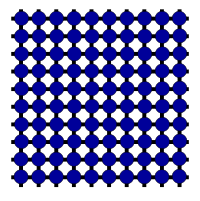- Fabric computing
-
Fabric computing or unified computing involves the creation of a computing fabric consisting of interconnected nodes that look like a 'weave' or a 'fabric' when viewed collectively from a distance.[1]
Usually this refers to a consolidated high-performance computing system consisting of loosely coupled storage, networking and parallel processing functions linked by high bandwidth interconnects (such as 10 Gigabit Ethernet and InfiniBand)[2] but the term has also been used to describe platforms like the Azure Services Platform and grid computing in general (where the common theme is interconnected nodes that appear as a single logical unit).[3]
The fundamental components of fabrics are "nodes" (processor(s), memory, and/or peripherals) and "links" (functional connection between nodes).[2] While the term "fabric" has also been used in association with storage area networks and switched fabric networking, the introduction of compute resources provides a complete "unified" computing system. Other terms used to describe such fabrics include "unified fabric"[4], "data center fabric" and "unified data center fabric".[5]
According to Ian Foster, director of the Computation Institute at the Argonne National Laboratory and University of Chicago, "grid computing 'fabrics' are now poised to become the underpinning for next-generation enterprise IT architectures and be used by a much greater part of many organizations."[3]
Brocade, Cisco, HP and Egenera currently manufacture computing fabric equipment.[6][7]
Contents
History
While the term has been in use since the mid to late 1990s[2] the growth of cloud computing and Cisco's evangelism of unified data center fabrics[8] followed by unified computing (an evolutionary data center architecture whereby blade servers are integrated or unified with supporting network and storage infrastructure[9]) starting March 2009 has renewed interest in the technology. Other companies offering unified or fabric computing systems include Liquid Computing Corporation and Egenera.
There have been mixed reactions to Cisco's architecture, particularly from rivals who claim that these proprietary systems will lock out other vendors. Analysts claim that this "ambitious new direction" is "a big risk" as companies like IBM and HP who have previously partnered with Cisco on data center projects (accounting for $2-3bn of Cisco's annual revenue) are now competing with them.[10][9]
Key characteristics
The main advantages of fabrics are that a massive concurrent processing combined with a huge, tightly-coupled address space makes it possible to solve huge computing problems (such as those presented by delivery of cloud computing services) and that they are both scalable and able to be dynamically reconfigured.[2]
Challenges include a non-linearly degrading performance curve, whereby adding resources does not linearly increase performance which is a common problem with parallel computing and maintaining security.[2]
See also
- Cloud computing
- Converged Infrastructure
- Grid computing
- Parallel processing (including massive parallel processing and MPPAs)
References
- ^ What Is: The Azure Fabric and the Development Fabric
- ^ a b c d e Massively distributed computing using computing fabrics
- ^ a b Grid computing: The term may fade, but features will live on
- ^ Unified Fabric: Benefits and Architecture of Virtual I/O
- ^ Intel: Data Center Fabric
- ^ Toolbox for IT: Data Center Fabric
- ^ Switch maker introduces a 'Data Center Fabric' architecture
- ^ Cisco: Unified Data Center Fabric: Reduce Costs and Improve Flexibility
- ^ a b "Cisco launches Unified Computing push with new blade server". ComputerWorld. 2009-03-16. http://www.computerworld.com/action/article.do?command=viewArticleBasic&articleId=9129718&intsrc=news_ts_head. Retrieved 2009-03-17.
- ^ "Cisco to sell servers aimed at data centers". Reuters. 2009-03-16. http://www.reuters.com/article/technologyNews/idUSTRE52F68W20090316. Retrieved 2009-03-17.
External links
Categories:- Cloud computing
- Distributed computing architecture
- Computer networking
Wikimedia Foundation. 2010.

